Pump Handbook by Igor J. Karassik, Joseph P. Messina, Paul Cooper, Charles C. Heald - 3rd edition
Подождите немного. Документ загружается.

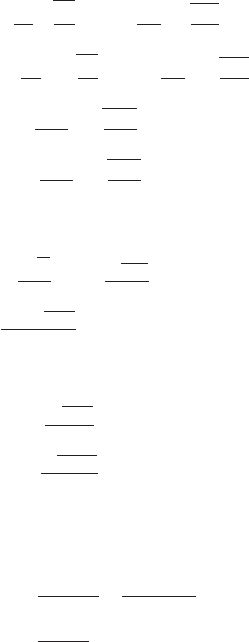
13 PUMP TESTING 13.41
dards
2
states that n has been found to vary from zero (when the surface roughness and
clearances of the model and prototype are proportional to their size) to 0.26 (when the
absolute roughness is the same in both).
When model tests are to serve as acceptance tests, it is generally recommended that
the efficiency guarantees be stated in terms of model performance rather than in terms of
calculated prototype performance. In the absence of such a provision, the efficiency stepup
formula and the numerical value of its exponent should be clearly specified or agreed upon
in advance of tests.
The Hydraulic Institute ANSI/HI 2000 Edition Pump Standards (Reference 10) give an
example of model testing as follows:
EXAMPLE A single-stage pump to deliver 200 ft
3
/s (5.66 m
3
/s) against a head of 400 ft
(122 m) at 450 rpm and with a positive suction head, including velocity head, of 10 ft
(3 m) has an impeller diameter of 6.8 ft (2.lm). The pump being too large for a shop or
laboratory test, a model with an 18-in (0.46-m) impeller is to be tested at a reduced head
at 320 ft (97.5 m). At what speed, capacity, and suction head should the test be run?
Applying the above relations:
in USCS units
in SI units
To check these results, the specific speed of the prototype is
in USCS units
in SI units
and that of the model is
in USCS units
in SI units
The cavitation factor for the field installation, assuming a water temperature of 80°F
(27°C) as a maximum probable value and H
b
32.8 ft (10 m) as in the first example,
will be
in USCS units
in SI units
where H
b
h
sa
H
vpa
(absolute atmospheric pressure minus absolute vapor pressure)
H
s
distance from datum to suction level
s
10 3
122
0.057
s
H
b
H
s
H
32.8 10
400
0.057
N
s1
1825
10.247
97.5
314
29
N
s1
1.825
18.73
320
3>4
71.2 1or 1,510 in the gpm system2
N
s
45015.66
122
3>4
39 in the m
3
>s system
N
s
N
2Q
H
3>4
450
1200
400
3>4
71.2 in the ft
3
>s system
Q
1
5.66 a
0.46
22.1
b
2
A
97.5
122
0.247 m
3
>s
N
1
450 a
2.1
0.46
b
2
A
97.5
122
1825 rpm
Q
1
Q a
D
1
D
b
2
B
H
1
H
200 a
1.5
6.8
b
2
A
320
400
8.73 ft
3
>s 3920 gpm
N
1
N
D
D
1
B
H
1
H
450 a
6.8
1.5
b
A
320
400
1825 rpm

13.42 CHAPTER THIRTEEN
which should be the same in the test. With the water temperature approximately
the same,
in USCS units
in SI units
Hence the model should be tested with a positive suction head of 14.6 ft (4.4 m) to
reproduce the field conditions.
Normally one of the requirements when using model tests as acceptance tests is to
make sure true geometric similarity exists between model and installed prototype. True
values of all required and specified dimension should be determined. The actual parts,
areas, shape, clearances, and positions should be clearly understood by all parties. Also,
the amount of permissible geometric deviation between prototype and model should be
agreed to, in writing, before the test is begun.
OTHER OBSERVATIONS_______________________________________________
Testing Noncentrifugal Pumps
The next largest class of pumps after centrifugal are
displacement pumps. This classification includes reciprocating, rotary, screw, and other
miscellaneous displacement pumps. Testing of these closely parallels the centrifugal pro-
cedures. Normally the capacities are smaller and the heads higher, but the objectives,
methods, and measurements are all about the same. The Hydraulic Institute ANSI/HI
2000 Edition Pump Standards (References 11 and 12) thoroughly cover testing of rotary
and reciprocating pumps.
The testing of pumps not falling into the two broad classifications of centrifugal and
displacement is usually very special, and each case must be treated separately. The test
procedures are normally spelled out in the specifications; otherwise an agreement between
all parties must be made before testing is started. The testing of eduction or jet pumps
falls under this special category of testing.
Other Test Phenomena When testing pumps, other phenomena of interest should also
be checked and noted on the test record. The two phenomena normally reported on are
vibration and noise. The acceptable limits of these plus instrumentation for measuring
them are special and normally covered in the contract. If the pumps are to be installed in
a special environment, this should also be taken into consideration during testing.
REFERENCES _______________________________________________________
1. American Society of Mechanical Engineers. “Performance Test Codes, Centrifugal
Pumps,” PTC 8.2-1990, ASME, New York, www.asme.org.
2. Hydraulic Institute. “Standards for Centrifugal, Rotary and Reciprocating Pumps,”
13th ed., 1975 (out of print).
3. American Society of Mechanical Engineers. “Fluid Meters: Their Theory and Applica-
tion,” 6th ed., ASME, New York, 1971.
4. Smith, H., Jr. “Hydraulics,” Wiley, New York, 1884.
5. Francis, J. B. “Lowell Hydraulic Experiments,” Van Nostrand, New York, 1883.
6. Shen, J. “A Preliminary Report on the Discharge Characteristics of Trapezoidal-Notch
Thin-Plate Weirs,” U.S. Geological Survey, 1959.
H
s1
10 10.0572197.52 4.4 m
H
s1
H
b
sH 32.8 10.057213202 14.6 ft
s
H
b
H
s1
H
1
13 PUMP TESTING 13.43
7. Parshall, R. L. “Improving the Distribution of Water to Farmers by Use of the Parshall
Measuring Flume,” Bulletin 488, Soil Conservation Service, U.S. Department of Agri-
culture, Washington, DC, 1945.
8. Parshall, R. L. “Measuring Water in Irrigation Channels with Parshall Flumes and
Weirs,” Bulletin 843, Soil Conservation Service, U.S. Department of Agriculture, Wash-
ington, DC, 1950.
9. “Water Measurement Manual.” 2nd ed., Bureau of Reclamation, U.S. Department of
Interior, Denver, CO, 1967.
10. American National Standards for Centrifugal Pump Tests, ANSI/HI 1.6-2000,
Hydraulic Institute, Parsippany, NJ, www.pumps.org.
11. American National Standards for Rotary Pump Tests, ANSI/HI 3.6-2000, Hydraulic
Institute, Parsippany, NJ, www.pumps.org.
12. American National Standards for Reciprocating Pump Tests, ANSI/HI 6.6-2000,
Hydraulic Institute, Parsippany, NJ, www.pumps.org.
13. Hydraulic Institute ANSI/HI 2000 Edition Pump Standards, Hydraulic Institute, Par-
sippany, NJ, www.pumps.org.
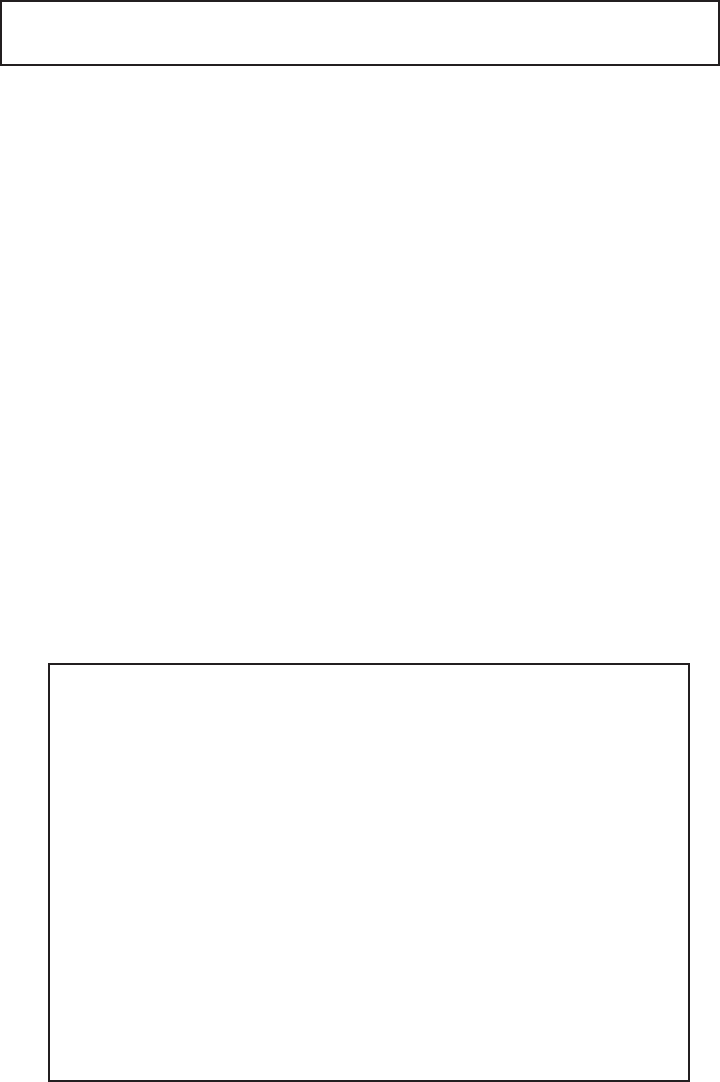
Technical
Data
A•P•P•E•N•D•I•X
Table 1A Base Units of the International System of Units (SI) and A.2
Their Definitions
Table 1B Supplementary SI Units and Their Definitions A.2
Table 2 Derived Units of the SI System A.3
Table 3 Prefixes of SI Multiple and Submultiple Units A.3
Table 4 Velocity and Frictional Head Loss in Old Cast Iron Piping A.4
Based on Hazen-Williams C 100
Figure 1 Change in Hazen-Williams Coefficient C with Years of A.6
Service for Cast Iron Pipes Handling Soft, Clear, Unfiltered
Water
Figure 2 Atmospheric Pressures for Altitudes up to 12,000 ft (3600 m) A.7
Table 5 Velocity and Frictional Head Loss in New Schedule 40 A.8
(Standard Weight) Steel Piping Based on Darcy-Weisbach
Table 6 Viscosity of Common Liquids A.10
Table 7 Viscosity Conversion Tables A.20
Table 8 Properties of Water at Temperatures from 40 to 705.4°F A.22
(4.4 to 374.1°C)
Table 9 Conversions of USCS to SI Units A.25
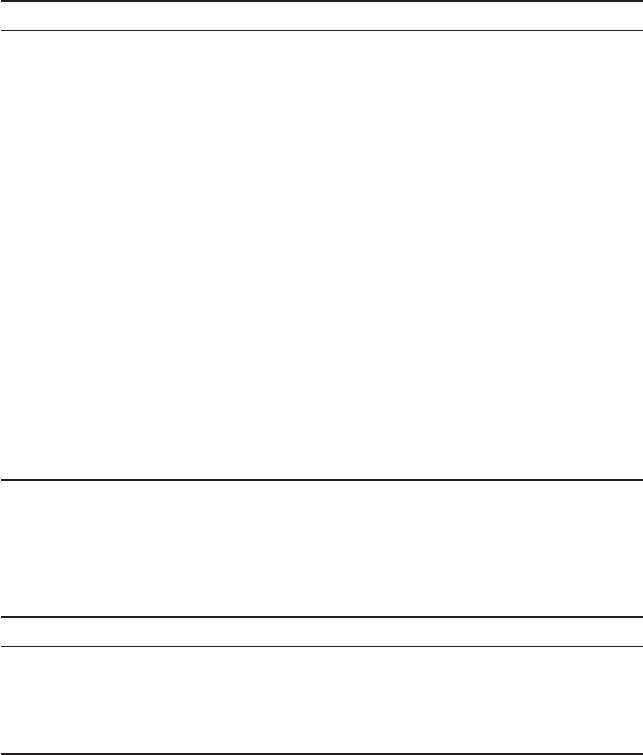
TABLE 1B Supplementary SI units
Symbol Unit Definition
rad radian Unit of measure of a planar angle with its vertex at the center
of a circle subtended by an arc equal in length to the radius
sr steradian Unit of measure of a solid angle with its vertex at the center of
a sphere and enclosing an area of the spherical surface equal
to that of a square with sides equal in length to the radius
A.2
APPENDIX
TABLE 1A Base units of the International System of Units (SI) and their definitions
Symbol Unit Definition
m meter
a
Unit of length equal to 1,650,763.73 wavelengths in vacuum of
the radiation corresponding to the transition between the
2p
10
and 5d
5
levels of the krypton-86 atom
kg kilogram Unit of mass equal to that of the international prototype of the
kilogram
s second Unit of time equal to the duration of 9,192,631,770 periods of
the radiation corresponding to the transition between two
hyperfine levels of the ground state of the cesium-133 atom
A ampere Unit of electric current equal to that which, if maintained in
two straight parallel conductors of infinite length and
negligible cross-section and placed 1 meter (m) apart in
vacuum, produces between those conductors a force equal to
2 10
7
newtons per meter (N/m) of length
K kelvin Unit of thermodynamic temperature equal to the fraction
1/273.16 of the thermodynamic temperature of the triple
point of water
cd candela Unit of luminous intensity equal to that (in the perpendicular
direction) of a surface of 1/600,000 m
2
of a blackbody at the
temperature of freezing platinum under a pressure of
101,325 newtons per square meter (N/m
2
)
mol mole Unit of substance equal to the moment of substance of a system
that contains as many elementary entities
b
as there are
atoms in 0.012 kg of carbon-12
a
Spelled metre in countries other than the United States.
b
When the mole is used, the elementary entities must be specified and may be atoms, molecules,
ions, electrons, other particles, or specified groups of each particles.

TABLE 3 Prefixes for SI multiple and submultiple units
Prefix SI symbol Multiplication factor
exa E 10
18
peta P 10
15
tera T 10
12
giga G 10
9
mega M 10
6
kilo k 10
3
hecto h 10
2
deka da 10
deci d 10
1
centi c 10
2
milli m 10
3
micro m 10
6
nano n 10
9
pico p 10
12
femto f 10
15
atto a 10
18
TECHNICAL DATA A.3
TABLE 2 Derived units of the SI system
Quantity Unit Symbol Formula
Acceleration meters per second per second m/s
2
—
Angular acceleration radians per second per second rad/s
2
—
Angular velocity radians per second rad/s
—
Area square meters m
2
—
Density kilograms per cubic meter kg/m
3
—
Energy joules J N m
Force newtons N kg m/s
2
Frequency hertz Hz cycle/s
Power watts W J/s
Pressure pascals Pa N/m
2
Stress newtons per square meter N/m
2
—
Velocity meters per second m/s
—
Viscosity, dynamic newton-seconds per square meter N s/m
2
—
Viscosity, kinematic square meters per second m
2
/s
—
Volume cubic meters m
3
—
Work joules J N m

TABLE 4 Velocity and frictional head loss in old cast iron piping based on Hazen-Williams C 100
gpm
a
v
b
f
c
vf vf vf vf vf vf vf vf gpm
3-in ID pipe
d
4-in ID pipe
30 1.36 0.534 0.77 0.131 5-in ID pipe 30
40 1.81 0.910 1.02 0.224 40
50 2.27 1.38 1.28 0.338 0.82 0.114 6-in ID pipe 50
60 2.72 1.92 1.53 0.475 0.98 0.160 60
70 3.18 2.56 1.79 0.631 1.14 0.213 0.79 0.088 70
80 3.63 3.28 2.04 0.808 1.31 0.273 0.91 0.112 80
90 4.08 4.08 2.30 1.01 1.47 0.339 1.02 0.139 90
100 4.54 4.96 2.55 1.22 1.63 0.412 1.14 0.170 8-in ID pipe 100
125 5.68 7.50 3.19 1.85 2.04 0.623 1.42 0.256 125
150 6.81 10.5 3.83 2.59 2.47 0.874 1.70 0.360 0.96 0.89 150
175 7.95 14.0 4.47 3.44 2.86 1.16 1.99 0.478 1.12 0.118 175
200 9.08 17.9 5.10 4.41 3.27 1.49 2.27 0.613 1.28 0.151 10-in ID pipe 200
225 10.2 22.3 5.74 5.48 3.68 1.85 2.55 0.762 1.44 0.188 225
250 11.3 27.1 6.38 6.67 4.08 2.25 2.84 0.926 1.60 0.228 1.02 0.077 250
275 12.5 32.3 7.02 7.96 4.50 2.68 3.12 1.11 1.76 0.272 1.12 0.092 275
12-in ID pipe
300 13.6 37.9 7.65 9.34 4.90 3.13 3.41 1.30 1.91 0.320 1.23 0.108 300
350 0.99 0.059 14-in ID pipe 15.9 50.4 8.93 12.4 5.72 4.20 3.97 1.73 2.23 0.425 1.43 0.144 350
400 1.13 0.076 18.2 64.6 10.2 15.9 6.54 5.38 4.54 2.21 2.55 0.545 1.63 0.184 400
450 1.28 0.094 0.94 0.044 11.5 19.8 7.36 6.68 5.10 2.75 2.87 0.678 1.84 0.228 450
500 1.42 0.114 1.04 0.054 12.8 24.1 8.18 8.12 5.68 3.34 3.19 0.823 2.04 0.278 500
16-in ID pipe
550 1.56 0.136 1.15 0.064 14.0 28.7 8.99 9.69 6.24 3.99 3.51 0.982 2.24 0.331 550
600 1.70 0.160 1.25 0.076 0.96 0.039 15.3 33.7 9.81 11.4 6.81 4.68 3.82 1.15 2.45 0.389 600
650 1.84 0.186 1.36 0.088 1.04 0.046 18-in ID pipe 16.6 39.1 10.6 13.2 7.38 5.43 4.15 1.34 2.65 0.452 650
700 1.99 0.214 1.46 0.100 1.12 0.052 17.9 44.9 11.4 15.1 7.94 6.23 4.47 1.53 2.86 0.518 700
750 2.13 0.242 1.56 0.114 1.20 0.060 0.95 0.034 12.3 17.2 8.51 7.08 4.78 1.74 3.06 0.589 750
800 2.27 0.273 1.67 0.129 1.28 0.067 1.01 0.038 20-in ID pipe 13.1 19.4 9.08 7.98 5.10 1.97 3.26 0.666 800
900 2.55 0.339 1.88 0.160 1.44 0.084 1.13 0.047 14.7 24.1 10.2 9.92 5.74 2.44 3.67 0.825 900
1,000 2.83 0.412 2.08 0.195 1.60 0.102 1.26 0.057 1.02 0.034 16.3 29.3 11.4 12.1 6.38 2.97 4.08 1.00 1,000
1,100 3.12 0.492 2.29 0.232 1.76 0.121 1.39 0.068 1.12 0.041 18.0 35.0 12.5 14.4 7.02 3.55 4.50 1.20 1,100
,200 3.40 0.578 2.50 0.273 1.92 0.143 1.51 0.080 1.23 0.048 13.6 16.9 7.66 4.17 4.90 1.41 1,200
A.4
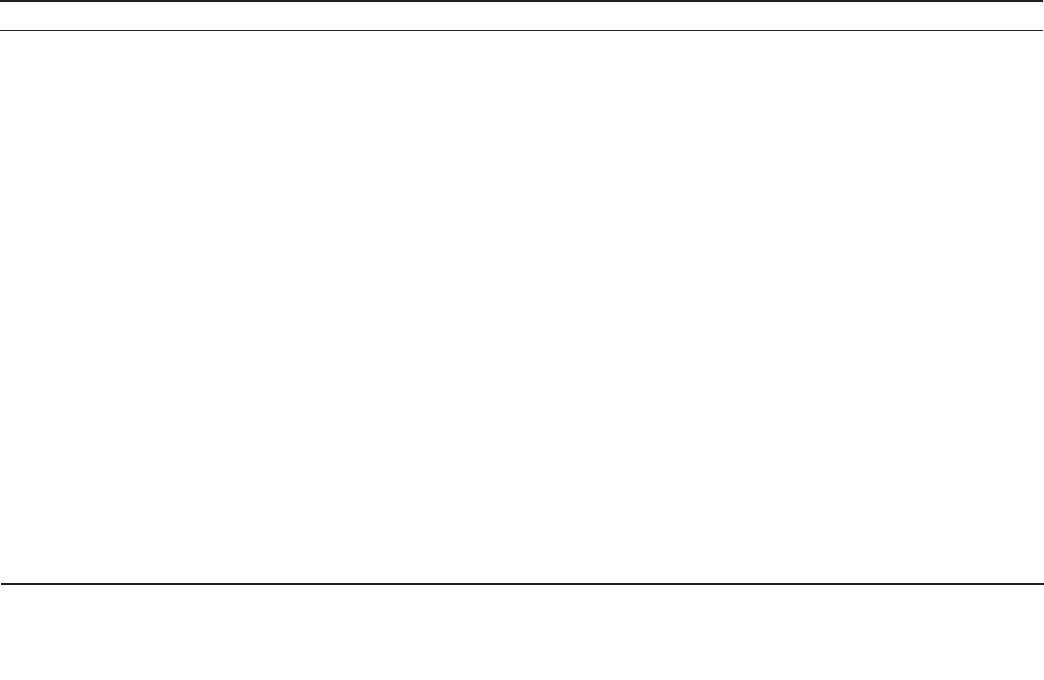
A.5
1,300 3.69 0.671 2.71 0.316 2.08 0.165 1.64 0.093 1.33 0.056 24-in ID pipe 14.8 19.6 8.30 4.83 5.31 1.63 1,300
1,400 3.97 0.770 2.92 0.363 2.24 0.190 1.76 0.107 1.43 0.064 15.9 22.5 8.93 5.54 5.72 1.87 1,400
1,500 4.25 0.875 3.12 0.413 2.40 0.215 1.89 0.121 1.53 0.073 1.06 0.030 17.0 25.5 9.55 6.30 6.12 2.13 1,500
1,600 4.54 0.985 3.33 0.465 2.55 0.243 2.02 0.137 1.63 0.082 1.13 0.034 18.2 28.8 10.2 7.10 6.53 2.39 1,600
1,800 5.11 1.22 3.75 0.578 2.87 0.302 2.27 0.170 1.84 0.102 1.28 0.042 11.5 8.83 7.35 2.98 1,800
2,000 5.67 1.49 4.17 0.703 3.19 0.367 2.52 0.207 2.04 0.124 1.42 0.051 12.8 10.7 8.17 3.62 2,000
2,500 7.09 2.25 5.21 1.06 3.99 0.555 3.15 0.312 2.55 0.187 1.77 0.077 16.0 16.2 10.2 5.48 2,500
3,000 8.51 3.16 6.25 1.49 4.78 0.778 3.78 0.438 3.06 0.262 2.13 0.108 19.1 22.8 12.3 7.67 3,000
3,500 9.93 4.20 7.29 1.98 5.59 1.04 4.41 0.583 3.57 0.349 2.48 0.143 14.3 10.2 3,500
4,000 11.3 5.38 8.33 2.54 6.39 1.33 5.04 0.746 4.08 0.447 2.83 0.184 16.3 13.1 4,000
4,500 12.8 6.68 9.38 3.15 7.18 1.65 5.67 0.928 4.59 0.555 3.19 0.228 18.4 16.3 4,500
5,000 14.2 8.13 10.4 3.83 7.98 2.00 6.30 1.13 5.10 0.675 3.54 0.278 5,000
5,500 15.6 9.70 11.5 4.58 8.78 2.39 6.93 1.35 5.61 0.806 3.90 0.332 5,500
6,000 17.0 11.4 12.5 5.38 9.68 2.81 7.56 1.58 6.12 0.947 4.25 0.390 6,000
6,500 18.4 13.2 13.6 6.24 10.4 3.26 8.19 1.83 6.73 1.10 4.61 0.452 6,500
7,000 19.9 15.2 14.6 7.16 11.2 3.74 8.82 2.11 7.15 1.26 4.96 0.518 7,000
7,500 15.6 8.13 12.0 4.24 9.45 2.39 7.66 1.43 5.32 0.589 7,000
8,000 16.7 9.16 12.8 4.79 10.1 2.69 8.17 1.61 5.66 0.664 8,000
9,000 18.8 11.4 14.4 5.95 11.3 3.39 9.18 2.01 6.38 0.825 9,000
10,000 16.0 7.24 12.6 4.07 10.2 2.44 7.09 1.00 10,000
11,000 17.6 8.63 13.9 4.86 11.2 2.91 7.80 1.20 11,000
12,000 19.2 10.1 15.1 5.71 12.3 3.42 8.51 1.41 12,000
13,000 16.4 6.62 13.3 3.96 9.12 1.63 13,000
14,000 17.6 7.59 14.3 4.54 9.93 1.87 14,000
15,000 18.9 8.63 15.3 5.27 10.6 2.13 15,000
16,000 16.3 5.82 11.3 2.40 16,000
18,000 18.4 7.24 12.8 2.98 18,000
20,000 14.2 3.62 20,000
25,000 17.7 5.48 25,000
a
1 gpm 6.31 105 m
3
/s 0.227 m
3
/h 0.0631 liters/s
b
Velocity, in feet per second. 1 ft/s 0.305 m/s
c
Frictional head loss, in feet of water per 100 feet of pipe. 1 ft 0.305 m. Friction values apply to cast iron pipes after 15 years of service handling average water at 60°F (15.6°C). Based
on Hazen-Williams formula with C 100. See Figure 1 for other values of C.
d
1 in 25.4 mm
TABLE 4
gpm
a
v
b
f
c
vf vf vf vf vf vf vf vf gpm
Continued.
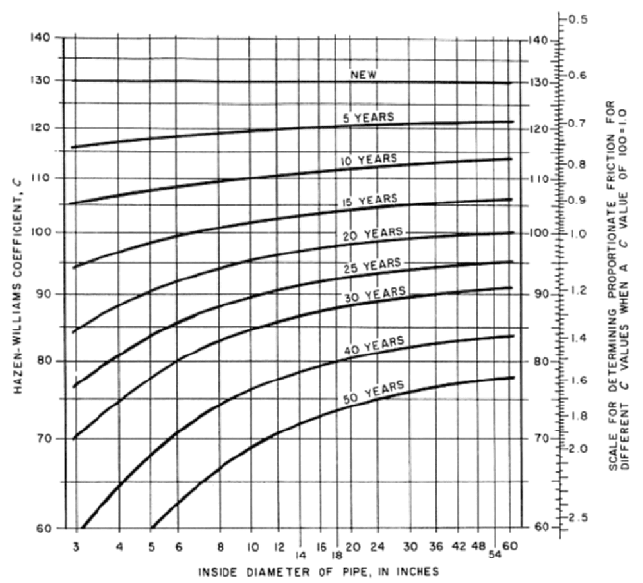
A.6 APPENDIX
FIGURE 1 Change in Hazen-Williams coefficient C with years of service, for cast iron pipes handling soft, clear,
unfiltered water at 60°F (15.6°C). To correct head loss from Table 4, which is based on C 100, multiply by the
conversion factor. For example, with a flow of 700 gpm through a 6-in pipe, the frictional head loss is 6.23 ft per 100
ft of pipe with C 100. For C 130, the conversion factor is 0.613; therefore, the frictional head loss is 6.23
0.613 3.82 ft per 100 ft of pipe (see also Section 8.1) (1 in 25.4 mm).
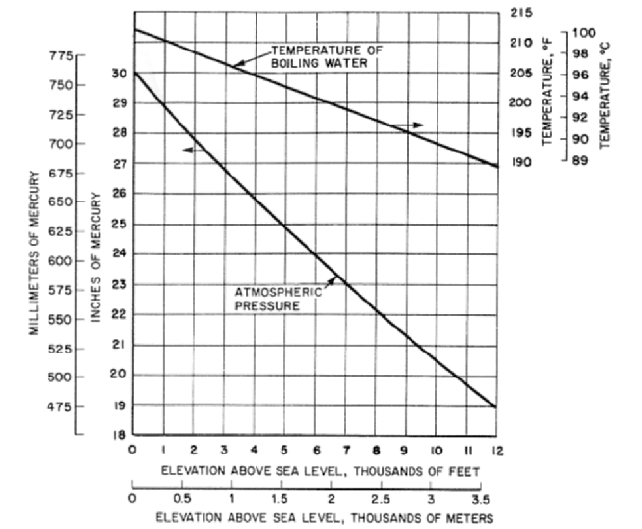
TECHNICAL DATA A.7
FIGURE 2 Atmospheric pressures for altitudes up to 12,000 ft (3600 m)
